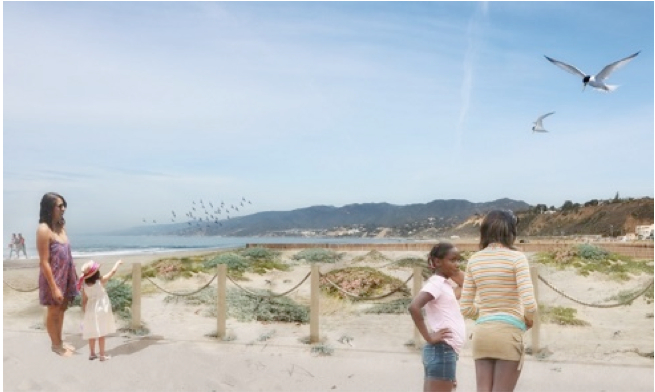CommentsBEGREEN--What happens when you change something as iconic as a Santa Monica beach…even just a small part of it? That’s one of the things The Bay Foundation (TBF), an environmental non-profit, in partnership with the City of Santa Monica, is eager to study as part of the newly-launched Santa Monica Beach Restoration Pilot Project. This project aims to transform an approximately three-acre section of existing sandy beach into a healthy, beautiful coastal ecosystem—a more ‘wild’ or natural beach—to address coastal hazard risks while protecting and enhancing coastal resources, such as public beach access and recreation, natural shoreline habitat, and aesthetic values.
The designated area is ocean-ward of the bike path near the water, parallel to the Beach Club, and about 1.5 miles north of the Santa Monica Pier. The wide beaches of Santa Monica provide a valuable environmental and economic resource, receiving 17 million visitors annually. Seventy-two million people visit the beaches throughout LA County in a given year.
So far this month, TBF’s staff of scientists have installed a low-lying, three-foot tall sand fence, both for protection and to designate the project area; have performed baseline monitoring for the study; and were able to take advantage of last week’s impending rain, seeding the space with native vegetation sooner than anticipated.
To transform this highly impacted beach, they seeded with native coastal strand species, such as flowering sand verbena and beach evening primrose. The project will evaluate increased protection from sea level rise and erosion for coastal infrastructure and residences, while also providing a vital refuge for locally rare coastal vegetation species, invertebrates, and birds.
The project is also meant to offer a beach aesthetic unique to the region, an opportunity to see how people in Los Angeles interact with this type of coastal ecosystem, and bird watching opportunities for visitors. One local homeowner, after learning about the project, said, “I wish it was a bigger project ending in a ribbon of natural plants…all along the beach.”
“The most exciting part of this project for me is the chance to show people what a different kind of beach can look like and what it can actually do,” states TBF Executive Director Tom Ford. “The multiple benefits of this project, if successful, are profound. This project may clearly demonstrate that the beach can again be a place for wildlife and people while providing protection from sea level rise in a very cost effective manner. In essence, we’re using Mother Nature to protect us from Mother Nature by providing Mother Nature with some space on our urban beach.”
In addition to the curved, flowing, low-lying fence lines, there is a path through the restoration area, and it is open along the water’s edge. Many of the design components were created to minimize disturbance and encourage visitors’ interaction with the beach, from normal recreation to enjoying and learning about the local native plants.
Karina Johnston, TBF’s Director of Watershed Programs, states, “We believe that the iconic beaches of Santa Monica are a beautiful and important location to test this restoration project, which uses existing sand to transform a portion of the current beach into a sustainable coastal strand and foredune habitat complex resilient to sea level rise.”
And since timing is everything, a separate but nearby project has a tangential focus. Until early January, the City of Santa Monica has a virtual reality installation on the Santa Monica Pier revealing how sea level rise will affect the Santa Monica shoreline in the not too distant future. Will its iconic beaches be underwater in 30 years? Could projects like the Santa Monica Beach Restoration Pilot Project help protect us? Inside the viewer is an immersive virtual reality display showing panoramic views of Santa Monica Beach accurate to the vantage point on the North side of the Pier, where it is mounted. The public can see how the beach and infrastructure will flood with sea level rise and big storms by the end of the century.
“Personally speaking I’m thrilled to be a part of all this!” adds Ford. “The City of Santa Monica, California State Parks and the folks neighboring the project have been so welcoming, it’s a very encouraging start. I can’t think of a better way to ring in the New Year.”
Learn more about the Santa Monica Beach Restoration Pilot Project, see beautiful artistic renderings (by Mia Lehrer + Associates), watch for volunteer and educational outreach events at http://www.santamonicabay.org/santa-monica-beach-restoration-pilot/.
(Julie Du Brow writes on behalf of The Bay Foundation. The Bay Foundation is a 501(c) 3 non-profit environmental group founded in 1990 to restore and enhance the Santa Monica Bay (from the LA-Ventura county line to the Palos Verdes Peninsula) and local coastal waters. The Foundation is the non-profit partner of the Santa Monica Bay Restoration Commission, raising and expending funds for research, education, planning, cleanup efforts and other priorities identified in the Commission’s Santa Monica Bay Restoration Plan.)
Explore
Our mission is to promote and facilitate civic engagement and neighborhood empowerment, and to hold area government and its politicians accountable.

 CityWatch Los Angeles
Politics. Perspective. Participation.
CityWatch Los Angeles
Politics. Perspective. Participation.
09
Tue, Dec














